
Concept explainers
(a)
Interpretation:
Whether
Concept introduction:
Sugars show different types of isomerism. They may be enantiomers, epimers, anomers, or diastereomers depending upon chirality and plane of symmetry in molecules. It also depends on stereochemistry of different carbons.
Answer to Problem 24.39AP
The compounds,
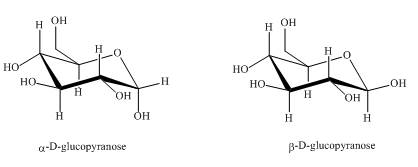
Explanation of Solution
The compounds,
They are diastereomers also as they are not mirror images of each other. The structure of both the compounds is shown below.

Figure 1
These two compounds are anomers as well as diastereomers as shown in Figure 1.
(b)
Interpretation:
Whether
Concept introduction:
Sugars show different types of isomerism between molecules. They may be enantiomers, epimers, anomers, or diastereomers depending upon chirality and plane of symmetry in molecules. It also depends on stereochemistry of different carbons.
Answer to Problem 24.39AP
The compounds,
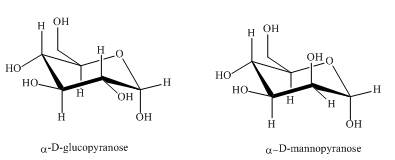
Explanation of Solution
Both the above structures of

Figure 2
The compounds
(c)
Interpretation:
Whether
Concept introduction:
Sugars show different types of isomerism between molecules. They may be enantiomers, epimers, anomers, or diastereomers depending upon chirality and plane of symmetry in molecules. It also depends on stereochemistry of different carbons.
Answer to Problem 24.39AP
The compounds,
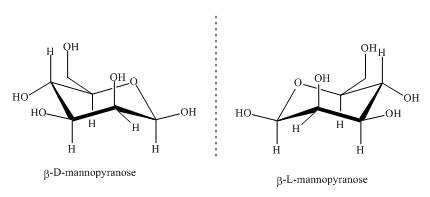
Explanation of Solution
Sugars can be divided into two groups based on the symmetry of carbon atoms. If the molecule has asymmetric carbon atom it will have a non superimposable mirror image. The non superimposable mirror images are known as enantiomers. As the given compounds are non super imposable mirror images of each other they are enantiomers. This can be well explained by the illustrations shown below.

Figure 3
These two compounds
(d)
Interpretation:
Whether
Concept introduction:
Sugars show different types of isomerism between molecules. They may be enantiomers, epimers, anomers, or diastereomers depending upon chirality and plane of symmetry in molecules. It also depends on stereochemistry of different carbons.
Answer to Problem 24.39AP
The compounds,
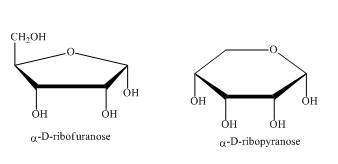
Explanation of Solution
As the isomers are the compounds, having similar chemical formula but different structures. These two compounds have same chemical formula. The chemical structure is of these two compounds is quite different as shown in Figure 4.

Figure 4
In the above shown compounds, one is a pentose sugar furanose while the other is a hexose sugar pyranose.
These two compounds,
(e)
Interpretation:
Whether
Concept introduction:
Sugars show different types of isomerism between molecules. They may be enantiomers, epimers, anomers, or diastereomers depending upon chirality and plane of symmetry in molecules. It also depends on stereochemistry of different carbons.
Answer to Problem 24.39AP
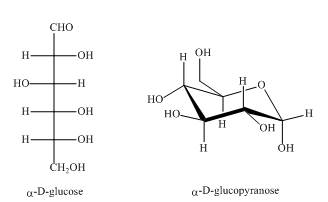
Explanation of Solution
As the isomers are the compounds, having similar chemical formula but different structures. Both the above structures are constitutional isomers as shown below in the Figure.

Figure 5
In the above shown compounds, one is a ring structure having keto group while the other is open ring structure having aldehyde as the
The given compounds
(f)
Interpretation:
Whether the compounds,
Concept introduction:
Sugars show different types of isomerism between molecules. They may be enantiomers, epimers, anomers, or diastereomers depending upon chirality and plane of symmetry in molecules. It also depends on stereochemistry of different carbons. The naming of the same compound can be done in different manners.
Answer to Problem 24.39AP
The compounds,
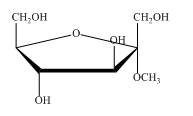
Explanation of Solution
The structure of

Figure 6
So, the compound is same, they are identical. In first name it is taken as methyl derivative of
The compound shown in Figure 6 can be named as
Want to see more full solutions like this?
Chapter 24 Solutions
Organic Chemistry
- Draw the Haworth projection of the disaccharide made by joining D-glucose and D-mannose with a ẞ(1-4) glycosidic bond. If the disaccharide has more than one anomer, you can draw any of them. Click and drag to start drawing a structure. Xarrow_forwardEpoxides can be opened in aqueous acid or aqueous base to produce diols (molecules with two OH groups). In this question, you'll explore the mechanism of epoxide opening in aqueous acid. 2nd attempt Be sure to show all four bonds at stereocenters using hash and wedge lines. 0 0 Draw curved arrows to show how the epoxide reacts with hydronium ion. 100 +1: 1st attempt Feedback Be sure to show all four bonds at stereocenters using hash and wedge lines. See Periodic Table See Hint H A 5 F F Hr See Periodic Table See Hintarrow_forward03 Question (1 point) For the reaction below, draw both of the major organic products. Be sure to consider stereochemistry. > 1. CH₂CH₂MgBr 2. H₂O 3rd attempt Draw all four bonds at chiral centers. Draw all stereoisomers formed. Draw the structures here. e 130 AN H See Periodic Table See Hint P C Brarrow_forward
- You may wish to address the following issues in your response if they are pertinent to the reaction(s) you propose to employ:1) Chemoselectivity (why this functional group and not another?) 2) Regioselectivity (why here and not there?) 3) Stereoselectivity (why this stereoisomer?) 4) Changes in oxidation state. Please make it in detail and draw it out too in what step what happens. Thank you for helping me!arrow_forward1) Chemoselectivity (why this functional group and not another?) 2) Regioselectivity (why here and not there?) 3) Stereoselectivity (why this stereoisomer?) 4) Changes in oxidation state. Everything in detail and draw out and write it.arrow_forwardCalculating the pH at equivalence of a titration 3/5 Izabella A chemist titrates 120.0 mL of a 0.7191M dimethylamine ((CH3)2NH) solution with 0.5501 M HBr solution at 25 °C. Calculate the pH at equivalence. The pk of dimethylamine is 3.27. Round your answer to 2 decimal places. Note for advanced students: you may assume the total volume of the solution equals the initial volume plus the volume of HBr solution added. pH = ☐ ✓ 18 Ar Boarrow_forward
- Alcohols can be synthesized using an acid-catalyzed hydration of an alkene. An alkene is combined with aqueous acid (e.. sulfuric acid in water). The reaction mechanism typically involves a carbocation intermediate. > 3rd attempt 3343 10 8 Draw arrows to show the reaction between the alkene and hydronium ion. that 2nd attempt Feedback 1st attempt تعمال Ju See Periodic Table See Hint F D Ju See Periodic Table See Hintarrow_forwardDraw the simplified curved arrow mechanism for the reaction of acetone and CHgLi to give the major product. 4th attempt Π Draw the simplified curved arrow mechanism T 3rd attempt Feedback Ju See Periodic Table See Hint H -H H -I H F See Periodic Table See Hintarrow_forwardSelect the correct reagent to accomplish the first step of this reaction. Then draw a mechanism on the Grignard reagent using curved arrow notation to show how it is converted to the final product. 4th attempt Part 1 (0.5 point) Select the correct reagent to accomplish the first step of this reaction. Choose one: OA Mg in ethanol (EtOH) OB. 2 Li in THF O C. Li in THF D. Mg in THF O E Mg in H2O Part 2 (0.5 point) Br Part 1 Bri Mg CH B CH, 1 Draw intermediate here, but no arrows. © TE See Periodic Table See Hint See Hint ין Harrow_forward
- Select the product for the following reaction. HO HO PCC OH ○ OH O HO ○ HO HO HOarrow_forward5:45 Х Select the final product for the following reaction sequence. O O 1. Mg. ether 2.D.Oarrow_forwardBased on the chart Two similarities between the molecule with alpha glycosidic linkages. Two similarities between the molecules with beta glycosidtic linkages. Two differences between the alpha and beta glycosidic linkages.arrow_forward

 Organic ChemistryChemistryISBN:9781305580350Author:William H. Brown, Brent L. Iverson, Eric Anslyn, Christopher S. FootePublisher:Cengage Learning
Organic ChemistryChemistryISBN:9781305580350Author:William H. Brown, Brent L. Iverson, Eric Anslyn, Christopher S. FootePublisher:Cengage Learning Introduction to General, Organic and BiochemistryChemistryISBN:9781285869759Author:Frederick A. Bettelheim, William H. Brown, Mary K. Campbell, Shawn O. Farrell, Omar TorresPublisher:Cengage Learning
Introduction to General, Organic and BiochemistryChemistryISBN:9781285869759Author:Frederick A. Bettelheim, William H. Brown, Mary K. Campbell, Shawn O. Farrell, Omar TorresPublisher:Cengage Learning


